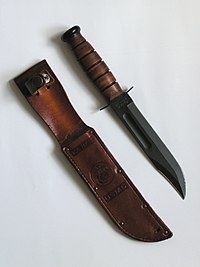Ka-Bar

Ka-Bar (trademarked as KA-BAR, capitalized) is a combat knife first obtained by the United States Marine Corps in November 1942.[1] It was then designated as the 1219C2 combat knife. Later it was called the USMC Mark 2 combat knife. When the United States Navy obtained the knife they called it the U.S. Navy utility knife, Mark 2.[2] KA-BAR is the trademark and namesake of a related knife manufacturing company, KA-BAR Knives., Inc. (formerly Union Cutlery Co.) of Olean, New York. KA-BAR Knives is a subsidiary of the Cutco Corporation.
History[change | change source]
At the start of World War II, the US Marine Corps was still using the World War I issue Trench knife. [1] Called the knuckle knife, it was a dagger with a studded steel hand guard.[3] The trench knife was suited for trench warfare but it did not meet the needs of the Marines in the Pacific war. The Marine Corps purchased different designs from different knife manufacturers. The Ka-Bar, however, quickly became the marine's favorite. They were made by the Union Cutlery Company (later changed to KA-BAR Cutlery Inc.).[4] Soon other companies were under contract to produce the Ka-Bar. The main use for the Ka-Bar combat knife was hand-to-hand combat with an enemy. However, the number of enemy soldiers killed with a Ka-Bar is thought to be very small.[5] The knife, weighing just over 1 pound (0.45 kg), had a solid pommel (the butt end of the knife) which could be used as a hammer.The knife was used to open food cans in c-rations or k-rations. It was used for cutting wires, opening crates of ammunition and other non-combat uses. [1]
Modern Ka-Bars[change | change source]

Although KA-BAR Knives, Inc. currently makes a wide variety of knives and cutlery, it is best known for the Ka-Bar Fighting/Utility knife. It has traditionally used a 7 inch (178 mm) long blade. It is made of 1095 carbon steel with a clip point blade and a stacked leather-washer handle. Other, more modern versions of this knife feature single or dual-edge blades. Many have synthetic handles made of Kraton (a non-slip rubber substitute).[6] For modern outdoor survival use the Ka-Bar knives are still a proven design.[7]
References[change | change source]
- ↑ 1.0 1.1 1.2 C. Peter Chen. "Mark 2 'KA-BAR' Blade". Lava Development, LLC. Retrieved 10 January 2016.
- ↑ Walker, Greg (2001). KA-BAR: The Next Generation of the Ultimate Fighting Knife. Boulder, Colorado: Paladin Press. pp. 13–20, 77. ISBN 1-58160-120-4.
- ↑ Barbara Schading, Richard Schading, A Civilian's Guide to the U.S. Military: A Comprehensive Reference to the Customs, Language and Structure of the Armed Forces (F+W Media, 2006), p. 301
- ↑ "The History of The Ka-Bar Fighting Knife". MilitaryItems.com. Retrieved 11 January 2016.
- ↑ Michael Green; Greg Stewart, Weapons of the Modern Marines (St. Paul, MN: MBI Publishing, 2004), p. 19
- ↑ Walker, Greg (2001). KA-BAR: The Next Generation of the Ultimate Fighting Knife. Boulder, Colorado: Paladin Press. pp. 5–8. ISBN 1-58160-120-4.
- ↑ Len McDougall, Practical Outdoor Survival: A Modern Approach to Staying Alive in the Wilderness (Guilford, CT: Lyons Press, 2008), p. 4
